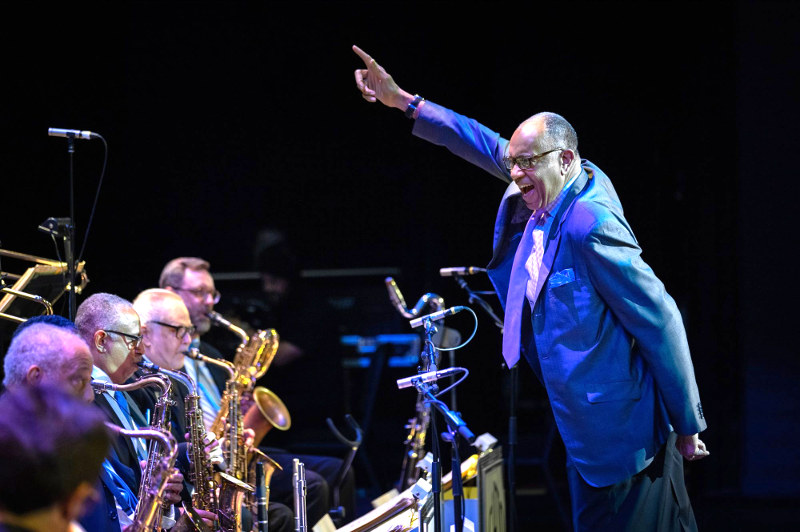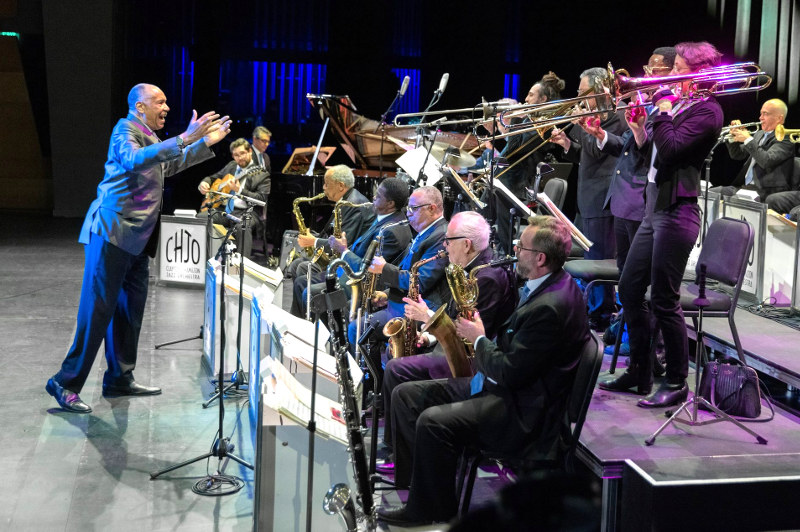
Ed. note: This story by jazz writer, Kirk Silsbee, was commissioned by The Soraya in advance of Conrad Tao & The Clayton-Hamilton Jazz Orchestra: Rhapsody in Blue on Saturday March 16. It is re-published with permission.
The February 12, 1924 premiere of George Gershwin’s “Rhapsody in Blue” was a musical earthquake. When the young prodigy put his hands to the keyboard, it set off a shift in the tectonic plates of American music—it was the first time jazz had been heard in a concert hall. Bandleader Paul Whiteman commissioned Gershwin to create a long-form piece infusing jazz elements into a classical form for his “Experiment in Modern Music” event at New York’s Aeolian Hall.
One hundred years later, the latest “Rhapsody” aftershock will rock The Soraya. Classical pianist Conrad Tao joins forces with the Clayton-Hamilton Jazz Orchestra and conductor Christopher Rountree to celebrate Gershwin’s triumph in (Whiteman’s famous syllogism) “making a lady out of jazz.” The core of the all-jazz program, conceived by Soraya Executive and Artistic Director Thor Steingraber, will include a solo piano set by Tao and new jazz arrangements by Clayton- Hamilton.
Brooklyn-born as the son of Jewish immigrants, Gershwin was a musical omnivore who absorbed the range of New York City’s creative cacophony: vaudeville, musical theater, concerts, cabarets, Tin Pan Alley tunes, Harlem stride pianists and bands, and the songs of Cuba. In songs written for Broadway revues, Gershwin and his brother, Ira, made their foundational contribution to the Great American Songbook. Gershwin’s music reflects the freneticism of urban life on the upswing and the optimism of his era. It was a soundtrack for a soon-to-be American Century.

Conrad Tao is no stranger to “Rhapsody in Blue.” He’s played it since 2008 with symphony orchestras across the country, and most recently while parrying with tap dance virtuoso Caleb Teicher. “It’s one of the most frequently performed pieces of American music,” said Tao, in anticipation of his second showcase at The Soraya. “It’s emblematic of the time and place, but it’s also timeless. Improvisation is baked into ‘Rhapsody in Blue.’ There are places in the score where the orchestra rests, and the pianist just takes off. That’s one of the reasons it continues to resonate with audiences today.”
Tao has been profiled in The New Yorker; named to the Forbes “30 Under 30” list; and called “the future of classical music” by New York magazine. A child prodigy, his exuberant performances and eagerness to explore uncharted musical territory caught the classical world’s attention. “I’m trained in the classical literature,” Tao said, “so I first learned the symphonic score of ‘Rhapsody’—so meticulous in its notation. Later on I learned about the chord symbols and lead sheets that a band like Whiteman’s would play.”
While Paul Whiteman led the most commercially popular American orchestra of the 1920s and early ‘30s, he always kept fine jazz soloists in his employ. Bix Beiderbecke, Frankie Trumbauer, Joe Venuti, Eddie Lang and Bunny Berigan all played for Whiteman. The famous opening clarinet cadenza of “Rhapsody in Blue”—a lower register rumbling that seems to slide up to the top of New York’s Chrysler Building—was a rehearsal improvisation. Gershwin liked it so much, he wrote it into the piece.

“Gershwin’s music is a shared language spoken by all jazz musicians,” said bassist and composer John Clayton, who reckons he’s been playing and arranging the canon, in one form or another, since first picking up a contrabass at thirteen years old. “Gershwin took all that was going on around him and reordered it in his own voice. Next thing you knew—there was a new style, a new form, a new genre.”
Jazz musicians at a jam session today are expected to know the Gershwin classics and conjure them at a simple mention. The familiar chords to “I Got Rhythm’ are inscribed in the jazz Torah, and Gershwin’s melodies and harmonies to tunes as imperishable as “Summertime,” “’S’Wonderful,” and “Someone to Watch Over Me” are songbook cornerstones. Tao recognizes their brilliance. “Gershwin’s work speaks to me,” he said. “The melodies are so perfect in their harmonic construction that they’re eternal. Whether I hear them in a concert hall, a ballroom, or an airport, they practically jump out at me. George Gershwin wrote one great tune after another, and they’re perfect for improvising on.”

Tao is going note-for-note with a big band known as the Cadillac of Los Angeles jazz orchestras. The Clayton-Hamilton Jazz Orchestra first convened at the tiny Silver Screen Lounge of the Hyatt on Sunset in 1986, where the bodies on the bandstand outnumbered those in the audience. Founded by John Clayton, his late saxophone-playing brother, Jeff, and drummer Jeff Hamilton, the band has gained an international reputation.
Supplementing this jazz juggernaut will be ensemble members of Wild Up, conducted by co-founder Christopher Rountree. Well known to Soraya audiences, Wild Up will add dimension to “Rhapsody” as the original orchestration includes a complete string section and other elements not typically found in a jazz ensemble.
Each of the evening’s artistic collaborators—Tao, Clayton-Hamilton, and Wild Up—has previously played The Soraya, but this three-part collaboration needed an impresario. “Thank goodness,” said Clayton, “Thor [Steingraber] has the audience support that allows him to will these ambitious collaborations and performances to life.”
“We love playing The Soraya,” said Clayton, “because of the sophistication of the audience, and the artistic challenges that come with it. Thor will call and say something like, ‘What do you think about working with Samara Joy?’” For Clayton, “That means I get to write new charts on her material. Working with Thor keeps my pencil sharp.”
Conrad Tao & The Clayton-Hamilton Jazz Orchestra: Rhapsody in Blue | The Soraya | Sat March 16
Kirk Silsbee, a frequent contributor to arts∙meme has written about jazz and culture for many years, publishing in Downbeat, Jazz Times, Los Angeles Times, and many other publications, as well as numerous CD liner notes.
